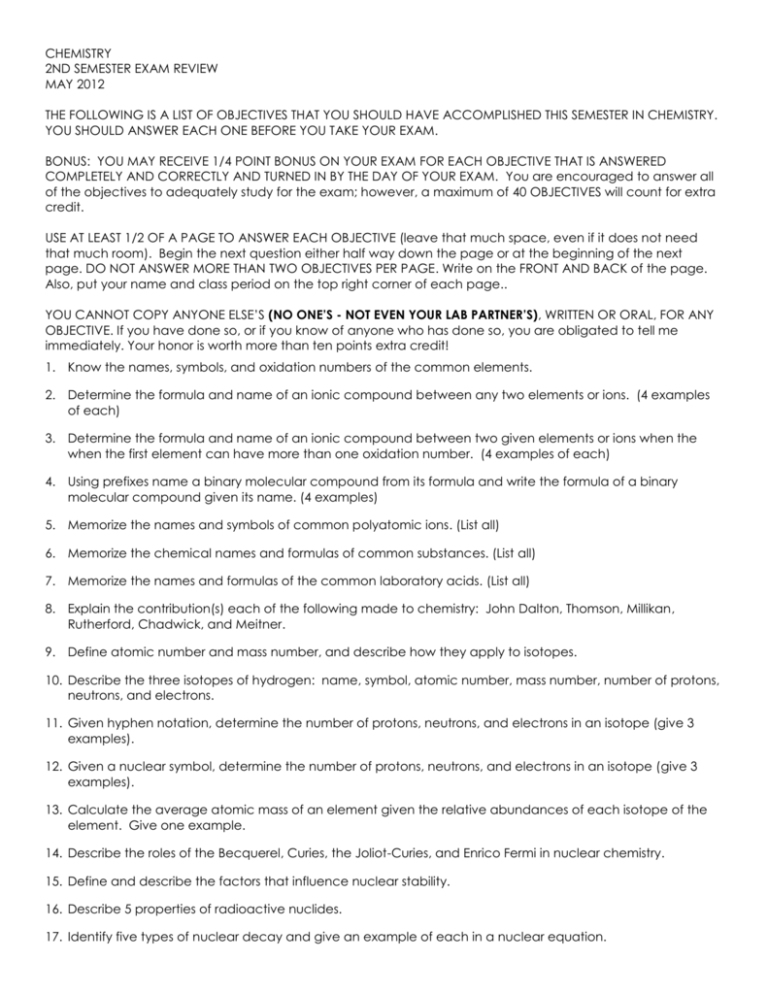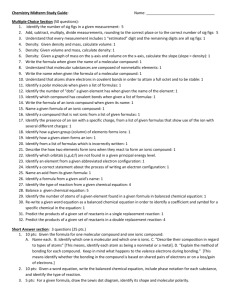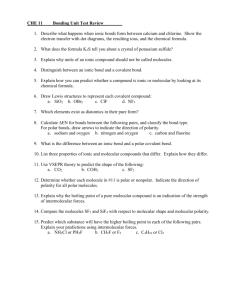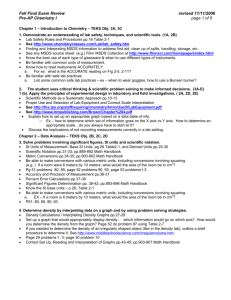Chemistry Exam Review Packet
advertisement

CHEMISTRY 2ND SEMESTER EXAM REVIEW MAY 2012 THE FOLLOWING IS A LIST OF OBJECTIVES THAT YOU SHOULD HAVE ACCOMPLISHED THIS SEMESTER IN CHEMISTRY. YOU SHOULD ANSWER EACH ONE BEFORE YOU TAKE YOUR EXAM. BONUS: YOU MAY RECEIVE 1/4 POINT BONUS ON YOUR EXAM FOR EACH OBJECTIVE THAT IS ANSWERED COMPLETELY AND CORRECTLY AND TURNED IN BY THE DAY OF YOUR EXAM. You are encouraged to answer all of the objectives to adequately study for the exam; however, a maximum of 40 OBJECTIVES will count for extra credit. USE AT LEAST 1/2 OF A PAGE TO ANSWER EACH OBJECTIVE (leave that much space, even if it does not need that much room). Begin the next question either half way down the page or at the beginning of the next page. DO NOT ANSWER MORE THAN TWO OBJECTIVES PER PAGE. Write on the FRONT AND BACK of the page. Also, put your name and class period on the top right corner of each page.. YOU CANNOT COPY ANYONE ELSE’S (NO ONE’S - NOT EVEN YOUR LAB PARTNER’S), WRITTEN OR ORAL, FOR ANY OBJECTIVE. If you have done so, or if you know of anyone who has done so, you are obligated to tell me immediately. Your honor is worth more than ten points extra credit! 1. Know the names, symbols, and oxidation numbers of the common elements. 2. Determine the formula and name of an ionic compound between any two elements or ions. (4 examples of each) 3. Determine the formula and name of an ionic compound between two given elements or ions when the when the first element can have more than one oxidation number. (4 examples of each) 4. Using prefixes name a binary molecular compound from its formula and write the formula of a binary molecular compound given its name. (4 examples) 5. Memorize the names and symbols of common polyatomic ions. (List all) 6. Memorize the chemical names and formulas of common substances. (List all) 7. Memorize the names and formulas of the common laboratory acids. (List all) 8. Explain the contribution(s) each of the following made to chemistry: John Dalton, Thomson, Millikan, Rutherford, Chadwick, and Meitner. 9. Define atomic number and mass number, and describe how they apply to isotopes. 10. Describe the three isotopes of hydrogen: name, symbol, atomic number, mass number, number of protons, neutrons, and electrons. 11. Given hyphen notation, determine the number of protons, neutrons, and electrons in an isotope (give 3 examples). 12. Given a nuclear symbol, determine the number of protons, neutrons, and electrons in an isotope (give 3 examples). 13. Calculate the average atomic mass of an element given the relative abundances of each isotope of the element. Give one example. 14. Describe the roles of the Becquerel, Curies, the Joliot-Curies, and Enrico Fermi in nuclear chemistry. 15. Define and describe the factors that influence nuclear stability. 16. Describe 5 properties of radioactive nuclides. 17. Identify five types of nuclear decay and give an example of each in a nuclear equation. 18. Define half-life and use it in a problem to find time passed and amount remaining (include 2 separate problems). 19. Describe four uses of radioactive isotopes. 20. Define nuclear fission, chain reaction, and nuclear fusion and distinguish between them. 21. Describe the function of control rods, nuclear fuel, moderators, and coolants in nuclear reactors. 22. Work problems with the frequency, wavelength and speed of electromagnetic radiation: c = λυ. Give one example. 23. Work problems with the frequency and energy of electromagnetic radiation using Planck’s constant: E = hυ. Give one example. 24. Discuss the significance of the photoelectric effect and the line-emission spectrum of hydrogen to the development of the atomic model. 25. Describe the Bohr model of the hydrogen atom. 26. List the four quantum numbers and describe their significance. 27. Relate the number of sub-levels corresponding to each of an atom’s main energy levels, the number of orbitals per sub-level, and the number of orbitals per main energy level. 28. Write the orbital notation and electron configuration notation. Give two examples of each. 29. State the Aufbau Principle, Hund’s rule, and the Pauli Exclusion Principle. 30. Describe the modern periodic table, including groups, periods, types of elements, and blocks. (Make a rough sketch with labels.) 31. Describe the relationship between electrons in sub-levels and the length of each period of the periodic table. 32. Compare and the contrast general properties of the alkali metals, the alkaline earth metals, and the transition metals, and describe their location in the Periodic Table. Give one example of each. 33. Compare and the contrast general properties of the halogens and the noble gases and describe their location in the Periodic Table. Give one example of each. 34. Know the uses and sources of the common elements on the periodic table. 35. Use electron configuration to determine the block, group, period and type of an element. Give one example from each block. 36. Define valence electrons and state how many are present in atoms of each s and p block element. 37. Write noble gas notation. Give four examples, one from each block. 38. State the octet rule and use it to describe ionic and covalent bonding. 39. State the octet rule and use it to describe ionic and covalent bonding. 40. Classify bonds according to electronegativity differences. (4 examples) 41. Write the Lewis structure for molecules or polyatomic ions containing both single and multiple bonds. (4 examples) 42. Compare the meaning of a chemical formula for a molecular compound and one for an ionic compound. 43. Define lattice energy and explain it significance. 44. List and compare the distinctive properties of ionic and molecular compounds. 45. Describe the electron-sea model of metallic bonding and explain why metals are malleable and ductile, but ionic compounds are not. 46. Define the VSEPR theory. 47. Describe dipole-dipole forces, hydrogen bonding, an induced dipole and London dispersion forces. 48. Use van der Waals forces to explain why molecules exist either as solids, liquids or gases at room temperature. 49. Use bond type to describe solubility. 50. Is ice more or less dense than liquid water? What would happen to fish if it weren’t? 51. Determine the formula and name of an ionic compound between any two given ions. (4 examples of each - Include an example of the system for naming ionic compounds when the metal has more than one charge.) 52. Using prefixes name a binary molecular compound from its formula and write the formula of a binary molecular compound given its name. (4 examples) 53. List the names and formulas of the common laboratory acids. 54. Balance a formula equation. (2 examples) 55. Describe five symbols that are used in chemical equations. 56. Define and give general equations for synthesis, decomposition, single replacement, and double replacement reactions. 57. List and give examples of five types of synthesis reactions and five types of decomposition reactions. 58. List and give examples of the five types of single replacement reactions, a double replacement reaction, and a combustion reaction. 59. Use the activity series to predict whether or not single replacement reaction will occur. Write two (2) balanced equations for reactions that will occur and two (2) examples of reactions that will not occur. 60. Use the activity series to predict whether or not synthesis and decomposition reactions will occur and what the product will be. Write two (2) balanced equations for reactions that will occur and two (2) examples of reactions that will not occur. 61. Why does soap burn when you get it in your eyes? List the general properties of acids and bases. 62. Why do you take Tums or Maalox when you have indigestion? 63. Describe how an acid-base indicator works and give three examples of indicators and their colors in each. 64. Why does shampoo need to be pH balanced like it says on commercials? Explain the pH scale. 65. Use the concentration of a solution of an acid or a base to the find the pH of the solution. (Two examples of each.)








